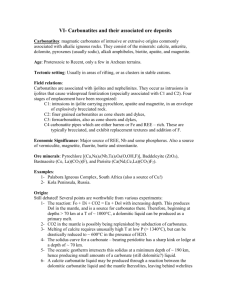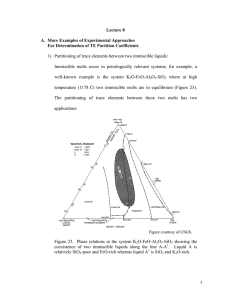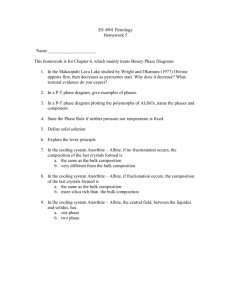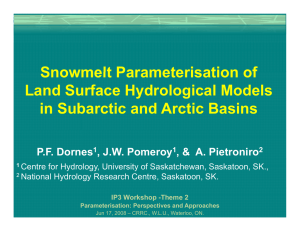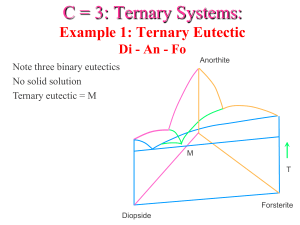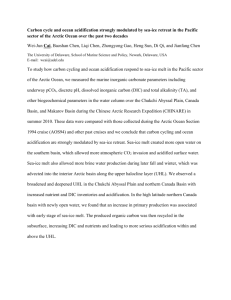1) We first focus on simple models that are... understanding of simple models provides insight into trace element behavior... Lecture 9
advertisement
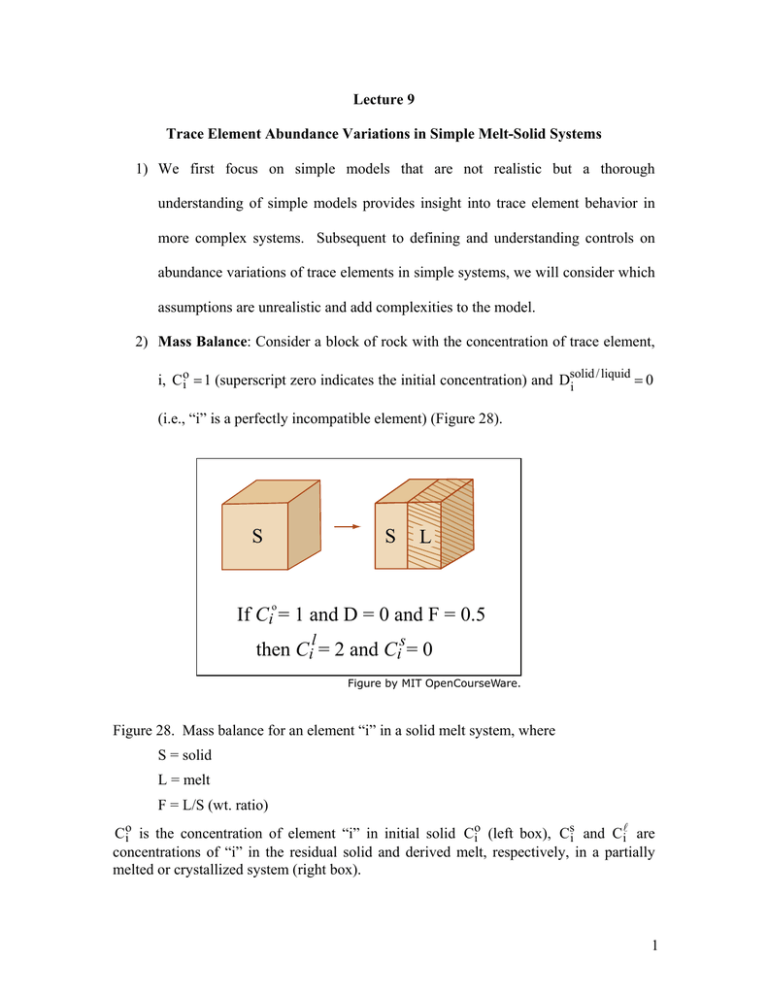
Lecture 9 Trace Element Abundance Variations in Simple Melt-Solid Systems 1) We first focus on simple models that are not realistic but a thorough understanding of simple models provides insight into trace element behavior in more complex systems. Subsequent to defining and understanding controls on abundance variations of trace elements in simple systems, we will consider which assumptions are unrealistic and add complexities to the model. 2) Mass Balance: Consider a block of rock with the concentration of trace element, / liquid =0 i, C oi = 1 (superscript zero indicates the initial concentration) and Dsolid i (i.e., “i” is a perfectly incompatible element) (Figure 28). S S L o If Ci = 1 and D = 0 and F = 0.5 l s then Ci = 2 and Ci = 0 )LJXUHE\0,72SHQ&RXUVH:DUH Figure 28. Mass balance for an element “i” in a solid melt system, where S = solid L = melt F = L/S (wt. ratio) Coi is the concentration of element “i” in initial solid Coi (left box), Csi and C li are concentrations of “i” in the residual solid and derived melt, respectively, in a partially melted or crystallized system (right box). 1 Now we ask if this solid mass of rock is melted to 50%, what is the concentration of “i” in the melt, i.e., C li = ? Since we are forcing all of the element “i” out of the solid into the melt, the ratio C li /C oi = 2. Similarly, if the solid is melted only 10%, C li /C oi =10. The important result that is characteristic of simple and complex models for partitioning of trace elements in solid-melt systems is that the abundance of a highly incompatible element in the melt is an inverse function of the melt fraction (F in wt.%). The mass balance equation showing that the whole system is a sum of its parts, i.e., initial solid = partial melt + residual solid, is C oi = C li F + Csi (1− F) where Coi concentration of i in initial solid C li = concentration of i in liquid Csi = concentration of i in the residual solid F = L/S, i.e. the wt. function of liquid (melt) Now we use the definition of partition coefficient, i.e., Dsi / l = Csi /C li and the mass balance equation to derive C li /C oi = 1 1 = F + Dsi / l − Dsi / lF F + Dsi / l (1− F) This equation has some very important limits: (a) As F → 0 C li /C oi = 1/D 2 Consequently, if D < 1, there is a maximum limit to the concentration of “i” in the melt and if D > 1, there is a limit to the depletion of “i” in the melt (Figure 29a). (b) As D → O C li /C oi = 1/F Consequently, for an incompatible element the enrichment of “i” in the melt is inverse to the melt fraction (Figure 29a). (c) Also for two elements A and B the change in abundance ratio from the initial solid to that of the melt is given by: (C A /C B ) l (C A /C B ) o = F + DsB/ l (1− F) F + DsA/ l (1− F) (C A /C B ) l so that for F = O the maximum change in DsB/ l (C A /C B ) l is given by , e.g., if D B = 0.5 and DA = 0.1, then (C A /C B ) o DsA/ l (C A /C B ) o = 5; this is the maximum change that is possible (Figure 29c). (d) Note that by using the mass balance equation, we are assuming that the solid and melt are homogeneous and in equilibrium. (e) Also, the mass balance equation and the equations derived from it are valid for partial melting and partial crystallization, i.e., the equations are equally valid for partial melting of an initial solid to various degrees or partial crystallization of a melt. (f) Also, for the solid the pertinent equation is Csi /C io = Dsi / l F + Dsi / l (1− F) (Figure 29b). 3 A 100 B 100 l Ci o Ci 0.0001 10 = o Ci D + F ( l - D) D D + F ( l - D) 10 0.01 Cil Cio s Ci l = D = 10 Cis Cio 0.1 1 1.0 5 2 1.0 2 1 5 0.01 D = 10 0.1 0 0.2 0.4 0.6 0.8 0.1 1.0 F 0 0.2 0.1 0.4 0.6 0.8 1.0 F C 5 Ratio of Two Incompatible Elements D = 0.5 D = 0.1 4 3 0.05 0.01 2 0.005 0.001 1 0.0 0.1 0.2 0.3 0.4 0.5 F )LJXUHE\0,72SHQ&RXUVH:DUH 1 o o Figure 29. a) Plot of the equation C L showing how C L i /C i i /C i = s / l s/l Di + F(1− Di ) varies as a function of F (wt. fraction of melt) and Dsi / l . o Note that as C iL /C io = 1 as F → 1, and that there is a maximum limit for C L i /C i = 1/ Dsi / l as F → 0. Dsi / l b) Plot of the equation Csi /C oi = s Di + F(1− Dsi / l ) showing how Csi /C oi varies as function of F and Dsi / l . c) Ratio of two incompatible elements in partial melts relative to initial ratio in unmelted solid, i.e. (C A /C B ) l /(C A /C B ) o as a function of F. Note that the maximum increase is given by the ratio of partition coefficients but that as F increases the ratio change is lower if the D’s are <<1. 4 3) Adding Realistic Complexities: So far we have considered the solid to be a single phase with a specific D. In reality rocks consist of multiple solid phases with different D’s. Hence we must define a bulk solid/melt partition coefficient, i.e., for a solid composed of phases α, β, and γ the bulk solid / melt=D αi / l x α +D βi / l x β +D γi / l x γ Di where x’s indicate wt. fractions of each phase in the solid. With this definition, the equation C li /C oi = 1 F+D bulk solid / melt is valid. (1− F) However, if one wants a realistic description of how C li /C oi varies with F there are two additional complexities: (a) The mineral/melt partition coefficient (i.e., Dα / l ,Dβ / l ,Dγ / l must be known as a function of melt and phase composition and variations in pressure and temperature. (b) Dbulk solid/melt will vary as mineral proportions in the solid change. As an example consider melting of a solid initially composed of weight fractions xαo ,xβo ,x γo with ∑= x io = 1. After partial melting the weight fractions of each phase contributing to the melt is Yα + Yβ + Yγ = ΔY, the total amount of melt. Therefore the initial bulk solid/melt partition coefficient solid / melt Dbulk = Dα / l xαo + Dβ / l xβo + Dγ / l x γo o becomes during the melting process 5 Dbulk solid / melt = Dα / l (xαo − Yα ) + Dβ / l (xβo − Yβ ) + Dγ / l (x γo − Y γ ) . 1− ΔY It is instructive to consider the effects on Dbulk solid/melt by substituting numerical / melt . values for x io and Dmineral i Case 1: For example, assume that xαi = xβo = 0.5, ΔY = 0.06 with Yα = Yβ = 0.03, Dα/ l = 0.01 and Dβ/ l = 0.1. Substitution of these values into the equation for variation of Dbulk solid/melt during the melting process leads to Dbulk solid/melt = (0.5-0.03)(0.01) + (0.5-0.03)(0.1) = 0.0517. Case 2: Now consider the effects on Dbulk solid/melt if only phase β, melts, i.e., Y β = 0.06. Then Dbulk solid/melt = (0.5)(0.01) + (0.5-0.06) 0.1 = 0.049. These calculations illustrate an important point: The major element composition in Case 1 is determined by a 50:50 mixture of phases α and β whereas in case 2 the major element composition of the melt is that of phase β . Thus the major element composition of the two melts are quite different, but since the Dbulk solid/melt for the generic trace element (i) is quite similar, the melts will have very similar contents of this trace element. Hence, this example illustrates how major and trace element compositions can be decoupled. Case 3: Another point is the sensitivity of trace element abundance to small amounts of a residual phase that preferentially incorporates the trace element; i.e. the trace element is highly compatible in a residual phase. For example, consider a solid with xαo = xβo = 0.495 , x γo = 0.01 and Dα / l = 0.01, Dβ / l = 0.1, D γ / l = 10, Yβ = 0.06 (only phase β melts). In this case: 6 Dbulk solid/melt = 0.495 (0.01) + (0.495 – 0.06)(0.1) + 0.01 (10) = 0.148, i.e., the Dbulk solid/melt value for Case 3 is ~3 times that for Cases 1 and 2! 4) Several important Generalizations Can Be Made (a) Unless phases melt in their modal proportion, an unlikely situation, the Dbulk solid/melt will vary with extent of melting even if the Dmineral/melt values remain constant, which is also an unlikely situation. (b) If a phase that is initially present completely melts, it has no effect on Dbulk solid/melt, and it has no effect on the trace element content of the melt. (c) As long as the fraction of a phase entering the melt relative to the initial fraction of the phase in the unmelted solid is small, the trace element content of the melt is independent of the phases that melt. Since the major element content of the melt is sensitive to the phases contributing to the melt, a decoupling of trace element and major element abundance is likely. (d) The trace element content of the melt can be controlled by small amounts of a phase with a large Dmineral/melt. An example for melting of upper mantle is garnet controlling abundances of heavy rare-earth elements (Figure 18). For melting of crustal rocks, likely examples are accessory phases such as zircon and apatite. In island arc settings rutile is an accessory phase which controls Ti, Nb and Ta (e.g., Schmidt et al., 2004). (e) Shaw (1970) showed that this variation in bulk solid/melt partition coefficient during the melting process can be expressed as Dsi / l = Doi − PF where Dsi / l is 1− F 7 the bulk solid/melt partition coefficient as partial melting progresses and Doi is the bulk solid/melt at the beginning of partial melting and P = Dα / lpα + Dβ / lpβ etc. where pj is the proportion of phase j in the melt, and ∑Pj = 1 (or j Yj in our earlier notation). ΔY Shaw further showed that if a solid melts in non-modal proportions the equation for modal melting C li /C oi = melting C li /C oi = 1 D oi + F(1 − P) 1 becomes for non-modal F + F(1 − Di ) . Correspondingly for the residual solid the equation for modal melting Dsi / l Csi /C io = s / l becomes for non-modal melting: Di + F(1− Dsi / l ) Csi /C oi = ⎞ 1 D oi − PF ⎛ ⎜⎜ o ⎟ . 1− F ⎝ D i + F(1− P) ⎠⎟ 8 MIT OpenCourseWare http://ocw.mit.edu 12.479 Trace-Element Geochemistry Spring 2013 For information about citing these materials or our Terms of Use, visit: http://ocw.mit.edu/terms.
